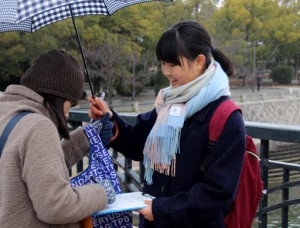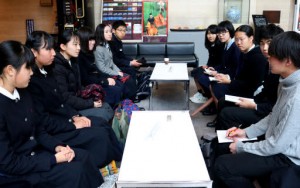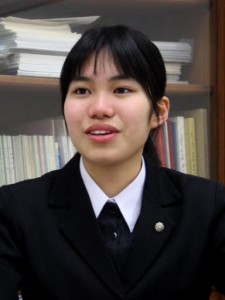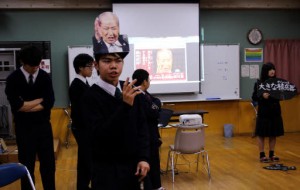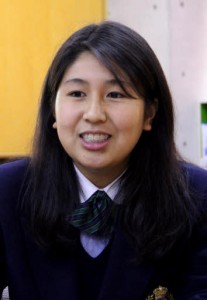Peace Seeds: Teens in Hiroshima Sow Seeds of Peace (Part 53)
Feb. 15, 2018
Part 53: Efforts by young people to help abolish nuclear weapons
Beatrice Fihn, the executive director of the International Campaign to Abolish Nuclear Weapons (ICAN), the non-governmental organization (NGO) that won the Nobel Peace Prize, visited Hiroshima in January and told the junior writers of the Chugoku Shimbun, “I think young people are essential. Young people are even more important than older people because you are the ones who will live in this world after us. If nuclear weapons are still around for another 75 years, until you’re old, then they might be used. Therefore, it’s really up to the young generation to demand that this change.”
Global conditions involving nuclear weapons are worsening. In order to abolish nuclear arms and their potential to annihilate the whole human race, and create a more peaceful future, the power of teenagers, who will assume the future, is clearly vital. For this article, the junior writers interviewed high school students in Hiroshima Prefecture who are actively making efforts to advance the abolition of nuclear weapons.
There may be limits to what our generation can do. But we feel that, through the exchange with junior writers, the small steps of students who have a sense of mission as young people from the Hiroshima area may generate some stronger momentum for the cause of nuclear abolition.
The 10,000 High School Students Signature Drive
At the end of January, eight members of the executive committee of the 10,000 High School Students Signature Drive were collecting signatures along the Motoyasu Bridge in the Hiroshima Peace Memorial Park. They told passersby, “We are gathering signatures to abolish nuclear weapons and create a peaceful world. We kindly ask for your cooperation.”
It was snowing, and when these high school students loudly voiced their appeal, citizens and international visitors stopped to sign their names. Many people also passed them by, but the students maintained a positive attitude and continued trying their very best to raise the public’s awareness of peace. They looked energetic and enthusiastic.
Ibuki Okamoto, 16, a first-year student from Onomichi Senior High School, said, “We go on with our efforts with the motto that ‘Our strength may be modest, but we are not powerless.’” The signature drive began in the city of Nagasaki in 2001, and in the city of Hiroshima it has been pursued once a month along the Motoyasu Bridge and other locations since 2011.
Every year, High School Student Peace Ambassadors, who are dispatched by the citizens of Hiroshima and Nagasaki, deliver the signatures to the United Nations Office in Geneva, Switzerland. To date, more than 1.6 million signatures have been submitted.
Konami Funai, 17, a second-year student at Eisugakkan Senior High School, was chosen as a High School Student Peace Ambassador and went to Geneva last year. She said, “To convey the horror of nuclear weapons to people of various situations and ideas is the first step toward realizing the abolition of nuclear weapons.” We, the junior writers, were very pleased to see so many young people taking part in the signature drive. We would like to take part in this effort, too. (Yoshiko Hirata, 16, and Riho Kito, 16)
Young people exchanging views
Seven young people who were taking part in the signature drive spoke with the junior writers.
Manaka Ikeuchi, 16, a first-year student at Kokutaiji High School, was participating in the signature drive for the first time. She said, “If we, as teens, don’t know much about the atomic bombing, we won’t be able to convey it to the next generation. I want to learn more about the atomic bombing.”
Minami Ito, 18, a third-year student from Funairi High School who served as a High School Student Peace Ambassador last year, said, “Even some local residents aren’t able to tell the day and time when the atomic bomb was dropped. It’s important that we draw the attention of other young people in Japan.”
Other comments made by participants in the signature drive included: “More international visitors, than Japanese, lent us their support. Japanese people need to have stronger feelings about peace”; and “Because we’re young, I think we can get various groups to work together and expand the circle of support.”
Offering their own views, the junior writers told the participants, “We were born in a time of peace, so we take peace for granted. We’d like to create opportunities for young people to change their perceptions by writing articles that can move them” and “It’s important to increase the number of teenagers who will share this vision.” (Terumi Okada, 16, Tokitsuna Kawagishi, 17)
High School Student Peace Ambassadors
Interview with Miharu Kobayashi, 17, the 20th Peace Ambassador
The program of High School Student Peace Ambassadors, who are chosen from young people and dispatched on trips overseas by the citizens of Hiroshima and Nagasaki to appeal for the abolition of nuclear weapons, was launched in 1998. This program was recommended as a candidate for the Nobel Peace Prize in January of this year. I interviewed Miharu Kobayashi, 17, a second-year student at the high school attached to Hiroshima University and a High School Student Peace Ambassador for the program’s 20th year.
Ms. Kobayashi became a High School Student Peace Ambassador last June and traveled to the United Nations Office in Geneva in August. She observed the U.N. Conference on Disarmament and learned that there are a variety of perspectives and approaches, though the shared goal of nuclear abolition must be advanced.
Ms. Kobayashi said: “When I was in kindergarten, I became interested in peace activities after I heard the principal say that there are many people in the world who suffer from a lack of food. When I was in elementary school, I learned about the atomic bombing and thought that, as a young person who was born in Hiroshima, I need to do something to help abolish nuclear weapons.”
“After I applied to be a High School Peace Ambassador, I asked my grandfather, whose mother was killed in the atomic bombing, about his A-bomb experience. It was the first time I asked, and some A-bomb survivors around me had already passed away before I was able to listen to their experiences. I regretted that I hadn’t listened to them even though I had many opportunities to do so. I really want the high school students in Hiroshima to listen to experiences of the A-bomb survivors in their lives.”
“We can now live happy lives in the revived city of Hiroshima. Living a happy life is also an important peace activity. Try to begin with what you can, such as taking part as a volunteer in the local community. As someone who speaks out for the A-bomb survivors, I want to make steady efforts to continue conveying their desire for peace.” (The interviewer was Naruho Matsuzaki, 17)
Human rights club at Eishin Junior & Senior High School
Last month, we observed the activities of the 28 members of the human rights club at Eishin Junior & Senior High School, located in the city of Fukuyama. On this day, we watched them practice for a presentation they would make at an elementary school. They used ideas that were carefully thought out, like quizzes and impressions of comedians, so that the elementary school students could understand the issues of the atomic bombing and nuclear weapons.
The members of the human rights club, who pursue activities involving peace and human rights, have met with former leprosy patients and victims of the Great East Japan Earthquake. Students of Eishin Junior & Senior High School, along with Hiroshima Jogakuin High School and Okinawa Shogaku Senior High School, are also helping to spearhead the signature campaign to advance the cause of nuclear abolition.
Recently, the club compiled a booklet on the life of A-bomb survivor Sunao Tsuboi, 92.
Yuta Takahashi, 17, a second-year student and the president of the club, said, “Young people, who are responsible for the future of our world, need to listen to the experiences and thoughts of the A-bomb survivors, and urge their children to work for peace as well. If we are considerate to the people around us, and interact with them with open hearts, hatred will disappear.”
I heard that many members of the human rights club have traveled overseas, including to U.N. headquarters in New York and the Vatican. Ai Shiokawa, 12, a first-year student at Eishin Junior High School, said with enthusiasm, “I enjoy taking part in these activities with everyone. I want to convey the horror of nuclear weapons at U.N. headquarters, like other students at my school have done.”
I was impressed to see young people of my generation doing their best to communicate messages of peace. I want to spread the importance of peace, too. (Yui Morimoto, 13)
Conveying the wish of the people of the A-bombed city
Interview with Yu Shigemasa, 17, who met Pope Francis
Yu Shigemasa, 17, a second-year student and a member of the human rights club at Eishin Senior High School, had the chance to meet Pope Francis last December. I interviewed her about her thoughts.
Ms. Shigemasa wrote a prize-winning essay for an essay contest commemorating the 75th anniversary of diplomatic relations between Japan and the Vatican and visited the Vatican as a goodwill ambassador. She said directly to the Pope, “I’ve come from Hiroshima. Please pray for the abolition of nuclear weapons,” and handed him folded paper cranes and folded paper roses.
The Pope responded by saying strongly that the atomic bombing of Hiroshima must not be forgotten. Ms. Shigemasa said, “After I returned to Japan, I learned that the Pope had made the order to have a photo that was taken in Nagasaki after the atomic bombing of that city, of a boy standing at attention after bringing the body of his younger brother to a cremation site, be widely distributed. I felt that the Pope was lending his support to my appeal.”
“My mother is from the Philippines,” she told me. “When I was in elementary school, I was bullied, and sometimes I wished that my mother was Japanese. But after I joined the human rights club, I began to think that I’m not ‘half’ but ‘double.’”
“Before, I wasn’t interested in peace studies. I just thought that the older students who went to the U.N. were cool. I’ve had the chance to meet different kinds of people through our club activities, and I feel strongly that the more I learn, the more I realize how little I actually know. I want to share my experience at the Vatican with many people and think together with others about how to pursue sustainable peace activities.” (The interviewer was Atsuhito Ito, 14)
What is Peace Seeds?
Peace Seeds are the seeds of smiles which can be spread around the world by thinking about peace and the preciousness of life from various viewpoints. To fill this world with flowering smiles, the junior writers, 25 junior high school and senior high school students, choose themes, gather information, and write articles.
(Originally published on February 15, 2018)
Beatrice Fihn, the executive director of the International Campaign to Abolish Nuclear Weapons (ICAN), the non-governmental organization (NGO) that won the Nobel Peace Prize, visited Hiroshima in January and told the junior writers of the Chugoku Shimbun, “I think young people are essential. Young people are even more important than older people because you are the ones who will live in this world after us. If nuclear weapons are still around for another 75 years, until you’re old, then they might be used. Therefore, it’s really up to the young generation to demand that this change.”
Global conditions involving nuclear weapons are worsening. In order to abolish nuclear arms and their potential to annihilate the whole human race, and create a more peaceful future, the power of teenagers, who will assume the future, is clearly vital. For this article, the junior writers interviewed high school students in Hiroshima Prefecture who are actively making efforts to advance the abolition of nuclear weapons.
There may be limits to what our generation can do. But we feel that, through the exchange with junior writers, the small steps of students who have a sense of mission as young people from the Hiroshima area may generate some stronger momentum for the cause of nuclear abolition.
The 10,000 High School Students Signature Drive
At the end of January, eight members of the executive committee of the 10,000 High School Students Signature Drive were collecting signatures along the Motoyasu Bridge in the Hiroshima Peace Memorial Park. They told passersby, “We are gathering signatures to abolish nuclear weapons and create a peaceful world. We kindly ask for your cooperation.”
It was snowing, and when these high school students loudly voiced their appeal, citizens and international visitors stopped to sign their names. Many people also passed them by, but the students maintained a positive attitude and continued trying their very best to raise the public’s awareness of peace. They looked energetic and enthusiastic.
Ibuki Okamoto, 16, a first-year student from Onomichi Senior High School, said, “We go on with our efforts with the motto that ‘Our strength may be modest, but we are not powerless.’” The signature drive began in the city of Nagasaki in 2001, and in the city of Hiroshima it has been pursued once a month along the Motoyasu Bridge and other locations since 2011.
Every year, High School Student Peace Ambassadors, who are dispatched by the citizens of Hiroshima and Nagasaki, deliver the signatures to the United Nations Office in Geneva, Switzerland. To date, more than 1.6 million signatures have been submitted.
Konami Funai, 17, a second-year student at Eisugakkan Senior High School, was chosen as a High School Student Peace Ambassador and went to Geneva last year. She said, “To convey the horror of nuclear weapons to people of various situations and ideas is the first step toward realizing the abolition of nuclear weapons.” We, the junior writers, were very pleased to see so many young people taking part in the signature drive. We would like to take part in this effort, too. (Yoshiko Hirata, 16, and Riho Kito, 16)
Young people exchanging views
Seven young people who were taking part in the signature drive spoke with the junior writers.
Manaka Ikeuchi, 16, a first-year student at Kokutaiji High School, was participating in the signature drive for the first time. She said, “If we, as teens, don’t know much about the atomic bombing, we won’t be able to convey it to the next generation. I want to learn more about the atomic bombing.”
Minami Ito, 18, a third-year student from Funairi High School who served as a High School Student Peace Ambassador last year, said, “Even some local residents aren’t able to tell the day and time when the atomic bomb was dropped. It’s important that we draw the attention of other young people in Japan.”
Other comments made by participants in the signature drive included: “More international visitors, than Japanese, lent us their support. Japanese people need to have stronger feelings about peace”; and “Because we’re young, I think we can get various groups to work together and expand the circle of support.”
Offering their own views, the junior writers told the participants, “We were born in a time of peace, so we take peace for granted. We’d like to create opportunities for young people to change their perceptions by writing articles that can move them” and “It’s important to increase the number of teenagers who will share this vision.” (Terumi Okada, 16, Tokitsuna Kawagishi, 17)
High School Student Peace Ambassadors
Interview with Miharu Kobayashi, 17, the 20th Peace Ambassador
The program of High School Student Peace Ambassadors, who are chosen from young people and dispatched on trips overseas by the citizens of Hiroshima and Nagasaki to appeal for the abolition of nuclear weapons, was launched in 1998. This program was recommended as a candidate for the Nobel Peace Prize in January of this year. I interviewed Miharu Kobayashi, 17, a second-year student at the high school attached to Hiroshima University and a High School Student Peace Ambassador for the program’s 20th year.
Ms. Kobayashi became a High School Student Peace Ambassador last June and traveled to the United Nations Office in Geneva in August. She observed the U.N. Conference on Disarmament and learned that there are a variety of perspectives and approaches, though the shared goal of nuclear abolition must be advanced.
Ms. Kobayashi said: “When I was in kindergarten, I became interested in peace activities after I heard the principal say that there are many people in the world who suffer from a lack of food. When I was in elementary school, I learned about the atomic bombing and thought that, as a young person who was born in Hiroshima, I need to do something to help abolish nuclear weapons.”
“After I applied to be a High School Peace Ambassador, I asked my grandfather, whose mother was killed in the atomic bombing, about his A-bomb experience. It was the first time I asked, and some A-bomb survivors around me had already passed away before I was able to listen to their experiences. I regretted that I hadn’t listened to them even though I had many opportunities to do so. I really want the high school students in Hiroshima to listen to experiences of the A-bomb survivors in their lives.”
“We can now live happy lives in the revived city of Hiroshima. Living a happy life is also an important peace activity. Try to begin with what you can, such as taking part as a volunteer in the local community. As someone who speaks out for the A-bomb survivors, I want to make steady efforts to continue conveying their desire for peace.” (The interviewer was Naruho Matsuzaki, 17)
Human rights club at Eishin Junior & Senior High School
Last month, we observed the activities of the 28 members of the human rights club at Eishin Junior & Senior High School, located in the city of Fukuyama. On this day, we watched them practice for a presentation they would make at an elementary school. They used ideas that were carefully thought out, like quizzes and impressions of comedians, so that the elementary school students could understand the issues of the atomic bombing and nuclear weapons.
The members of the human rights club, who pursue activities involving peace and human rights, have met with former leprosy patients and victims of the Great East Japan Earthquake. Students of Eishin Junior & Senior High School, along with Hiroshima Jogakuin High School and Okinawa Shogaku Senior High School, are also helping to spearhead the signature campaign to advance the cause of nuclear abolition.
Recently, the club compiled a booklet on the life of A-bomb survivor Sunao Tsuboi, 92.
Yuta Takahashi, 17, a second-year student and the president of the club, said, “Young people, who are responsible for the future of our world, need to listen to the experiences and thoughts of the A-bomb survivors, and urge their children to work for peace as well. If we are considerate to the people around us, and interact with them with open hearts, hatred will disappear.”
I heard that many members of the human rights club have traveled overseas, including to U.N. headquarters in New York and the Vatican. Ai Shiokawa, 12, a first-year student at Eishin Junior High School, said with enthusiasm, “I enjoy taking part in these activities with everyone. I want to convey the horror of nuclear weapons at U.N. headquarters, like other students at my school have done.”
I was impressed to see young people of my generation doing their best to communicate messages of peace. I want to spread the importance of peace, too. (Yui Morimoto, 13)
Conveying the wish of the people of the A-bombed city
Interview with Yu Shigemasa, 17, who met Pope Francis
Yu Shigemasa, 17, a second-year student and a member of the human rights club at Eishin Senior High School, had the chance to meet Pope Francis last December. I interviewed her about her thoughts.
Ms. Shigemasa wrote a prize-winning essay for an essay contest commemorating the 75th anniversary of diplomatic relations between Japan and the Vatican and visited the Vatican as a goodwill ambassador. She said directly to the Pope, “I’ve come from Hiroshima. Please pray for the abolition of nuclear weapons,” and handed him folded paper cranes and folded paper roses.
The Pope responded by saying strongly that the atomic bombing of Hiroshima must not be forgotten. Ms. Shigemasa said, “After I returned to Japan, I learned that the Pope had made the order to have a photo that was taken in Nagasaki after the atomic bombing of that city, of a boy standing at attention after bringing the body of his younger brother to a cremation site, be widely distributed. I felt that the Pope was lending his support to my appeal.”
“My mother is from the Philippines,” she told me. “When I was in elementary school, I was bullied, and sometimes I wished that my mother was Japanese. But after I joined the human rights club, I began to think that I’m not ‘half’ but ‘double.’”
“Before, I wasn’t interested in peace studies. I just thought that the older students who went to the U.N. were cool. I’ve had the chance to meet different kinds of people through our club activities, and I feel strongly that the more I learn, the more I realize how little I actually know. I want to share my experience at the Vatican with many people and think together with others about how to pursue sustainable peace activities.” (The interviewer was Atsuhito Ito, 14)
What is Peace Seeds?
Peace Seeds are the seeds of smiles which can be spread around the world by thinking about peace and the preciousness of life from various viewpoints. To fill this world with flowering smiles, the junior writers, 25 junior high school and senior high school students, choose themes, gather information, and write articles.
(Originally published on February 15, 2018)

